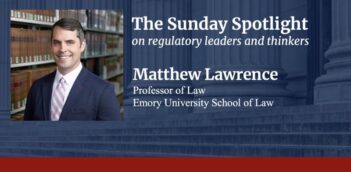
Scholars worry that regulating new technologies will be more difficult after recent Supreme Court decisions.
What do human clones and self-driving cars have in common? In both cases, U.S. administrative agencies have taken steps to regulate these brand-new technologies—and have done so without any new specific legislative authorization from the U.S. Congress.
But according to two legal scholars, a new doctrine announced by the U.S. Supreme Court earlier this year may jeopardize agencies’ ability to regulate emerging technologies in the future. In a forthcoming article, Walter G. Johnson and Lucille M. Tournas argue that the Court’s new major questions doctrine will hinder agencies’ ability to issue new rules or use existing laws to govern new technologies, potentially resulting in regulatory vacuums that threaten public health and safety.
Regulators will still be able to use softer tools and certain types of inter-agency coordination, but ultimately regulatory officials will need political support if they are to adopt binding regulations that address the risks of new technologies, contend Johnson and Tournas.
Johnson and Tournas acknowledge that new technologies can make important improvements to the quality of life and health—but they also observe that new technologies can present unique challenges and risks to safety, equity, and autonomy. Accordingly, regulating new technologies is important to protect the public, argue Johnson and Tournas.
They explain that, in the past, agencies used a variety of tools to address technology early in its development, including applying existing or “inherited” regulatory schemes. In this way, for example, the United States has effectively banned human cloning, even though Congress has never enacted legislation on the matter. Instead, after the birth of a cloned sheep, Dolly, sparked global policy debate in the late 1990s, the U.S. Food and Drug Administration (FDA) asserted its authority to act under its existing medical products rules. FDA has continued to govern in this area despite a lack of federal legislation specifically authorizing it to do so.
But Johnson and Tournas argue that recent Supreme Court decisions announcing a major questions doctrine have threatened agencies’ ability to use either new or inherited regulation to address new technologies. Most notably, the Supreme Court struck down an environmental rule in West Virginia v. Environmental Protection Agency on the basis that the agency had acted under a statute that did not, in fact, authorize it to cover such an important issue. In doing so, the Court formally announced a new doctrine which requires an agency to have clear statutory authorization to act on an issue of major political or economic significance.
Proponents of the major questions doctrine reason that it restores constitutional order to administrative law by ensuring Congress retains all legislative power. But Johnson and Tournas argue that the new doctrine will invite burdensome judicial scrutiny of attempts to regulate novel technologies. They specifically note the doctrine’s tendency to apply when agencies address new issues—a tendency that they see could “strike at the heart” of governmental regulation of emerging technologies.
Johnson and Tournas further contend that governance of emerging technologies is necessarily political and usually has significant economic consequences. This means that the major questions doctrine could apply even when a regulation’s political and economic effects are uncertain. They note that the Supreme Court’s recent decisions invalidated actions by agencies before those actions had even taken full effect.
Johnson and Tournas claim that this increase in regulatory vulnerability will result in troubling pockets of regulatory vacuum. They predict that agency decisionmakers will either attempt to regulate new technologies and face the political and legal ramifications. Or, in the alternative, they will shy away from regulating new technologies altogether.
Congress is unlikely to act swiftly on its own to fill the gaps, according to Johnson and Tournas. Legislators rarely prioritize novel technological issues because of their complexity and perceived unimportance, they argue.
Johnson and Tournas note, however, that agencies will still have access to “soft law” tools, such as setting voluntary standards. Indeed, some scholars have argued that soft law can be beneficial in emerging areas such as artificial intelligence.
But Johnson and Tournas counter that soft law tools will be less effective without the option to issue binding rules through new or inherited regulation. Effective agency coordination often involves a combination of binding regulation and soft law tools. Even when regulators use soft law on its own, its success depends in large part on the threat of state action, according to Johnson and Tournas.
They point to the U.S. Department of Transportation’s program on autonomous vehicles, through which the agency has published guidance and developed a voluntary reporting program. Johnson and Tournas argue that removing or weakening the agency’s ability to issue binding rules could weaken developers’ willingness to comply with voluntary standards.
What, then, are agencies to do? Johnson and Tournas doubt that legal strategies will effectively prevent or solve challenges to regulation of emerging technologies.
Instead, they suggest shifting regulatory strategies. They recommend that agencies continue using soft tools to encourage stakeholder compliance and even promote congressional action. They also suggest that agencies work together, which could allow them to combine their congressionally delegated authority to cover technologies they could not have regulated alone.
In addition, regulators can “enroll” nonstate actors, such as professional organizations, into regulatory activity by inducing them into setting and enforcing standards.
Johnson and Tournas also contend that successful regulation of novel technologies will require regulators to build political support for legislative authorization. That support will likely need to come from the creation of convincing non-technical narratives in support of public governance of technologies, claim Johnson and Tournas. They contend that effective public narratives should also support the legitimacy of the administrative state and the idea that regulating technology can actually promote innovation.
Ultimately, Johnson and Tournas argue that regulators, stakeholders, and legislators must work together to ensure that new technologies remain a force for good in modern life—and, to do so, they must protect agencies’ ability to govern.



